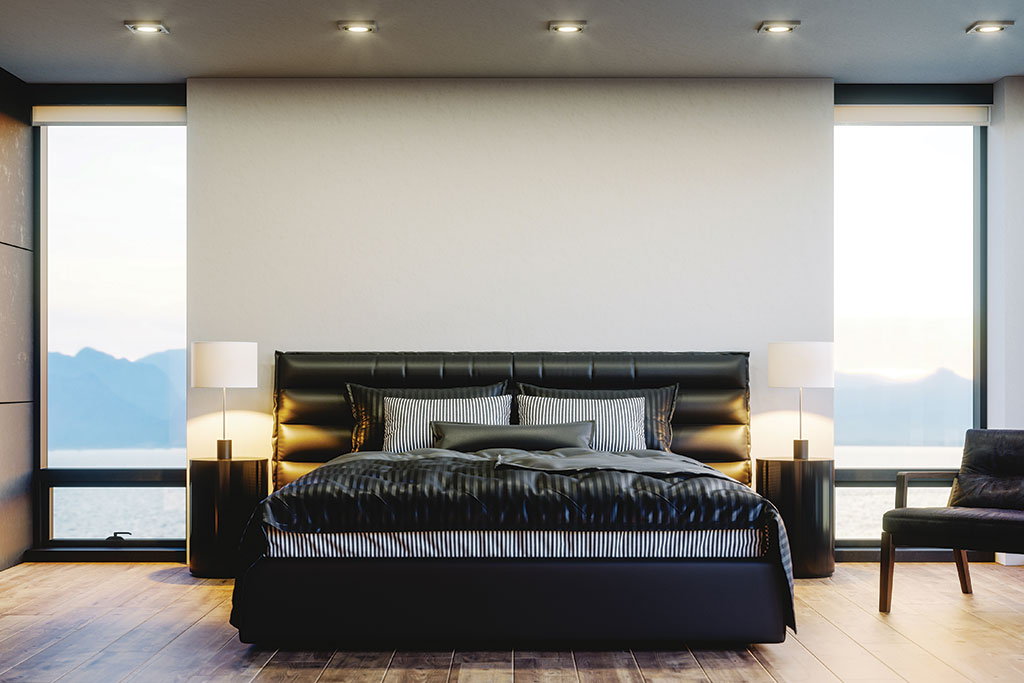When it comes to good interior design, there are many factors to consider, including style, color, and texture.
But perhaps the most important of these by far, especially in the darker and shorter days of winter, is lighting. (Switch off your home’s lamps and overhead fixtures on an overcast day or after the sun has set, and you’ll see why.) Without adequate light, the beauty of everything in your home, from the artwork to the furnishings, will be dimmed. To improve the function and livability of your home, consider implementing these tips on how to best use lighting to illuminate your spaces.

Layer it
Your home’s interior will look its best when you incorporate at least two different kinds of artificial light sources in a space, whether it’s ambient, accent, or task lighting.
Ambient lighting
To strike a good balance in a room, first select an ambient source of light—one that is bright enough to illuminate most of the space. A good choice is overhead lighting, which could include options like a chandelier or recessed ceiling lights. Whatever fixture you choose, its size should be appropriate for the room. A simple way to determine this is to measure the length and width of the room in feet and add those numbers together, the sum of which will tell you the diameter in inches that your light fixture should be. So if you have a 10-foot-by-12-foot room, the ceiling fixture should be about 22 inches wide.
Accent lighting
Once you’ve decided on your ambient lighting, add accent lighting to bring warmth into the space and showcase its special features. For instance, you could add a table lamp to highlight a console table in your living room or set uplights on the floor to put focus on a colorful houseplant collection. And don’t forget the corners of your rooms; you could utilize beautiful torchères or table lamps to illuminate these often overlooked areas.
Task lighting
Depending on the room and how you use it, you may also want to include lighting that can amplify and facilitate the function of the space. Examples include a desk lamp brightening a workspace in a home office and a floor lamp providing light in a reading nook.
Suit your space
Though each room should have a mix of ambient, accent, and task lighting, which ones work best will depend on the space’s unique function, look, and feel. Consider these room-by-room suggestions.
Living room
Place a semiflush drum ceiling fixture in the center, layer in an arched reading light over the sofa and a table lamp on a console table, and put a floor lamp in a corner or two to balance the space.
Kitchen
Recessed ceiling lights can brighten this area, LED strip lights tacked underneath upper cabinets will provide useful task lighting, and a chandelier hung over the kitchen table may lend extra style and ambience.
Bedroom
Softer lighting will make this room feel cozier, so think about installing an overhead fixture such as a drum flush-mount ceiling light with a linen shade, some wall sconces, and one or two bedside lamps for nighttime reading.
Bathroom
An oversized pendant light in the center of the space can brighten what might be an otherwise dark room. Eradicate shadows by placing a backlit mirror on the wall behind the vanity, and if you have a freestanding tub, draw attention to it by hanging a glamorous chandelier above it.

Choose hue and brightness
Another consideration when designing a home’s lighting is the type of bulbs you use. These days, the most commonly used ones are LEDs—which are also the most energy efficient. For your main living spaces, pick ones with a warm glow. If you need a bulb for bright task lighting, such as for a laundry or craft room, get one that’s about 5,000 kelvin. You can also consider the bulb’s lumen rating, which describes its brightness, when buying LEDs.
For a more tailored option, select dimmable LED bulbs with an LED-compatible dimmer to easily dial their brightness up and down. Lampshades can also soften lighting and bring in personality and style. If you want a moody look, choose thicker lampshades in dark colors; for an airy appearance, go with light-colored ones. Similarly, clear glass lampshades will allow more light to shine through while opaque ones will cut down the brightness.
Create a focal
point Light fixtures can do more than just illuminate a space—when chosen wisely, they can also help shape the vibe of the room. For instance, a crystal chandelier can add elegance to a dining room and a traditional Tiffany-style lamp can lend a classic look to a study. When it comes to selecting the most appropriate fixtures for your home, think of style first. Here are some popular options:
Black and brass metals
These finishes will look great whether your design style is traditional, midcentury modern, or transitional. And don’t be afraid to mix these metals in the same space.
Natural fixtures
Choosing ceiling lights, lamps, and other fixtures made from sustainable and eco-friendly materials like jute, wood, and glass can add a cozy or rustic look to your home.
Smart lights
Go with this option if your style is modern or if you’d like to use technology such as a smart home assistant to turn lights on and off or dim them. Most varieties will also allow you to change the color of the light.
194 Views